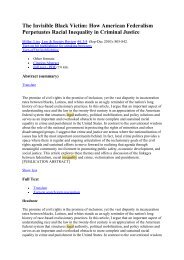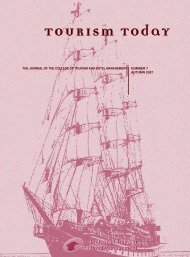Beyond the Qualitative Interview: Data Preparation and ... - E-Journal
Beyond the Qualitative Interview: Data Preparation and ... - E-Journal
Beyond the Qualitative Interview: Data Preparation and ... - E-Journal
You also want an ePaper? Increase the reach of your titles
YUMPU automatically turns print PDFs into web optimized ePapers that Google loves.
McLellan et al. / DATA PREPARATION 67<br />
research question or <strong>the</strong>ory may be all that are needed (Emerson, Fretz, <strong>and</strong><br />
Shaw 1995). In some instances, <strong>the</strong> audiotapes may be used to supplement<br />
(“bring in quotes” or “add depth”) or clean up researchers’ summary notes<br />
(Fasick 1977; Emerson, Fretz, <strong>and</strong> Shaw 1995; Crawford, Leybourne, <strong>and</strong><br />
Arnot 2000). Strauss <strong>and</strong> Corbin (1990:31) indicated that text selected for<br />
transcription should take into account <strong>the</strong> analytical contribution it will provide<br />
to <strong>the</strong> overall study.<br />
The level of transcription should complement <strong>the</strong> level of <strong>the</strong> analysis<br />
(Drisko 1997:190). If an analysis focuses on providing an in-depth description<br />
of <strong>the</strong> knowledge, attitudes, values, beliefs, or experiences of an individual,<br />
a group of individuals, or groups of individuals, a greater number <strong>and</strong><br />
possibly lengthier units of text need to be included in <strong>the</strong> transcript. With this<br />
type of analysis, researchers are not only interested in identifying patterns<br />
<strong>and</strong> salient <strong>the</strong>mes. They also want to demonstrate variations in how social<br />
phenomena are framed, articulated, <strong>and</strong> experienced as well as <strong>the</strong> relationships<br />
within <strong>and</strong> between particular elements of such phenomena. If<br />
researchers do not need such a detailed analysis, <strong>the</strong> exploration of general<br />
<strong>the</strong>mes <strong>and</strong> patterns can be undertaken with less text.<br />
In addition to ascertaining whe<strong>the</strong>r full, partial, or summary transcription<br />
will sufficiently meet analytical needs, attention to text relevance is required.<br />
What to include should always be driven by <strong>the</strong> research question that an<br />
analysis attempts to answer. And to effectively work with transcript (document)<br />
summaries, “granularity of analysis” must be closely tied into context<br />
<strong>and</strong> rely on linguistic phrases (Boguraev et al. 1998).<br />
Generally, transcripts benefit by including appropriate labeling <strong>and</strong> content-related<br />
information. Regardless of <strong>the</strong> analytical approach or tools used,<br />
we find it useful to include a transcription header or coversheet with basic<br />
information about an interview participant. As illustrated in <strong>the</strong> protocol,<br />
changes in audiotapes <strong>and</strong> <strong>the</strong> end of <strong>the</strong> interview are contained in <strong>the</strong> body<br />
of <strong>the</strong> transcript. By documenting tape changes (i.e., when a new tape is<br />
used), we are able to note when <strong>the</strong> logistics of h<strong>and</strong>ling recording equipment<br />
may result in an “unnatural” disruption in <strong>the</strong> discussion or when information<br />
may have been recorded only partially. To avoid accidentally recording over<br />
an interview tape, <strong>the</strong> use of <strong>the</strong> flip side of a tape is discouraged strongly.<br />
The “end-of-interview” line signals that <strong>the</strong> interview session had formally<br />
reached completion.<br />
The “Source Labeling” section of <strong>the</strong> protocol addresses text layout information,<br />
which allows us to quickly visually scan documents <strong>and</strong> identify<br />
whe<strong>the</strong>r <strong>the</strong> text is associated with <strong>the</strong> interviewer or <strong>the</strong> interviewee. Each<br />
time an individual speaks, his or her text is transcribed as a discrete unit of<br />
text <strong>and</strong> assigned a speaker label (i.e., a source ID). To fur<strong>the</strong>r assist us in














